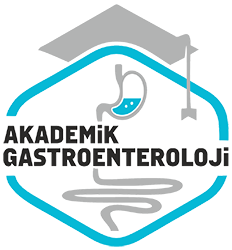Nisan 2019
Akut pankreatitli hastalarda serum endocan düzeyinin klinikle ilişkisi: Serum endocan akut pankreatitte biyomarker olabilir mi?
Relationship between serum endocan levels and clinical follow-up in patients with acute pancreatitis: Can serum endocan be a biomarker for acute pancreatitis?
- Ana Sayfa
- Sayılar
- Nisan 2019
- Akut pankreatitli hastalarda serum endocan düzeyinin klinikle ilişkisi: Serum endocan akut pankreatitte biyomarker olabilir mi?...
Saglik Bilimleri Üniversitesi, S.B. Derince Egitim ve Arastirma Hastanesi, 2Gastroenteroloji Klinigi, 4Biyokimya Bölümü, Derince, Kocaeli
S.B. Kargi Devlet Hastanesi, 3Iç Hastaliklari Bölümü, Kargi, Çorum
Özet
Giriş ve Amaç: Akut pankreatit seyrinde hastalığın prognozunu tayin etmek için birçok belirteç ve skorlama sistemleri kullanılmaktadır. Bu çalışmada endocan düzeyinin hafif ve şiddetli pankreatit vakalarinda C-reaktif protein, Ranson skoru, revize Atlanta skorlamasi ve diğer laboratuvar göstergeleri ile ilişkisi karsilastirilarak prognozu öngörmede öneminin arastirilmasi planlanmıştır. Gereç ve Yöntem: çalışmada 50 akut pankreatit hastası prospektif olarak incelendi, başvuru ani, 2. ve 7. günlerde endocan, biyokimyasal parametreler ve C-reaktif protein değerleri ölçüldü. Hastaların şikayet ile başvuru arasındaki zaman, yatış süreleri, skorlama sistemlerine göre pankreatit şiddeti Ranson ve revize Atlanta skoru olarak kaydedildi. Verilerin istatistiksel analizinde SPSS 22.0 paket programi kullanildi. Bulgular: Hastaların yaş ortalaması 61.36±16.21 yıl olup olup %54’ü kadındi. Ranson skoruna göre 20 olgu (%30) şiddetli pankreatit idi. Endocan değerleri hafif pankreatit grubu ve şiddetli pankreatit grubu ile karsilastirildiginda başvuru aninda, 2. ve 7. günlerde anlamli sonuç vermemıştır. Revize Atlanta skorlamasina göre siniflandi- rilan hasta gruplarinin serum endocan ile karsilastirilmasinda istatistiksel açidan fark görülmedi. Pankreatit şiddeti için 2. gün bakilan C-reaktif protein şiddetli pankreatitte ortalama 95.05 mg/L, hafif pankreatitte ise 77.06 mg/L olarak saptandi. diğer laboratuvar göstergelerinden alanin aminotransferaz, aspartat aminotransferaz, gama glutamil transferaz, alkalen fosfataz, total bilirübin ve direkt bilirübin hastalığın şiddeti ile korele saptandi. Sonuç: Akut pankreatit prognozu ile endocan arasındaki ilişkiyi daha net ortaya koymak için daha genis kapsamli prospektif çalışmalara ihtiyaç vardır.
Abstract
Background and Aims: Several markers and scoring systems are used to determine the prognosis of acute pancreatitis. In this study, the role of endocan in predicting prognosis was investigated by comparing the relation between C-reactive protein, the Ranson score, the revised Atlanta classification, and other laboratory indicators in patients with mild and severe pancreatitis. Materials and Methods: Fifty acute pancreatitis patients were studied prospectively. Endocan, biochemical parameters, and C-reactive protein values were measured at the time of admission and on the second and seventh days. The time between complaints and patient admission, the length of stay, and the severity of pancreatitis according to the Ranson score and revised Atlanta classification were recorded. The SPSS 22.0 statistical package was used for data analysis. Results: The mean patient age was 61.36±16.21 years, and 54% of patients were female. According to the Ranson score, 20 cases (30%) had severe pancreatitis. When endocan levels in the mild and severe pancreatitis groups were compared at the time of application and at the second and seventh days, there were no statistically significant differences. There were no statistically significant differences in serum endocans between groups of patients classified according to the revised Atlanta scoring system. When patients were subdivided according to pancreatitis severity, the mean C-reactive protein levels on the second day were 95.05 mg/L in patients with severe pancreatitis and 77.06 mg/L in patients with mild pancreatitis. Other laboratory indices, such as alanine aminotransferase, aspartate aminotransferase, gamma-glutamyl transferase, alkaline phosphatase, total bilirubin, and direct bilirubin, were correlated with disease severity. Conclusion: To clarify the relationship between the prognosis of acute pancreatitis and endocans, more extensive prospective studies are needed



